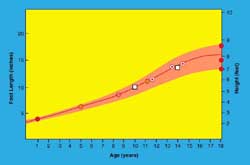|
|

|

FAQ Home > What is a Bigfoot, or Sasquatch?
Physiology | The sasquatch is a predominantly nocturnal animal and its night vision exceeds that of man substantially. It is probable that this increase in night vision is a function of a larger eye and pupillary size rather than a reflecting layer. The animals walk with ease in seeming total darkness, but forage during the day. An indication of their nighttime activity is the fact that they are seen as frequently during the night, if not more often, than during the day, despite the limited sight distance and detection by nocturnal observers.
Other Senses
In parallel with other large primates, sasquatch senses are acute but probably not more so than those of a human aborigine, e.g., American Indians before the deterioration of their senses by pollution and noise. They detect the approach of man by simply remaining still in forested environment, but there have been many occasions where a sasquatch failed to detect a resting person in full view, simply because the animal was preoccupied and the person did not move or make a sound.
The sasquatch seems hardened to pain and discomfort, living in, to our perception, disagreeable climates and walking through blackberry thickets, Devil’s Club, icy streams, and sharp rocks without deviation, though they seem to value on occasion the soft comfort of mole hills, moss or a freshly graded berm of a forest road, as their footprints testify.
Diet and Digestion
The sasquatch is an omnivore with a substantial carnivorous component to its diet. They have been observed directly to eat leaves, berries, fruits, roots, aquatic plants and other vegetable matter, catch fish, dig up clams or ground squirrels, and prey on poultry, deer, elk and bear. In addition, they eat other odd items, such as young evergreen shoots, crayfish, road kill, meat or fish from human storage sites, hunter-killed game animals (these sometimes snatched in front of the hunter), and occasional garbage. They take an occasional livestock animal, but not with sufficient frequency as to produce organized persecution.
They appear to kill large prey animals by a blow with the fist, rock or stick or by twisting their necks, sometimes to the point of decapitation. Liver and other internal organs are their first targets. The remaining meat is sometimes stored on the ground under a haphazard shelter of sticks or lifted into tree forks above ground. No compelling evidence exists that they store food in any substantial way beyond this; only rarely has a sasquatch been observed carrying a fish some distance from its origin, or a deer, presumably into hiding.
Caloric requirements per gram of living matter decrease as a function of total mass of the animal. Nonetheless, the nutritional needs of an average sasquatch can be calculated to amount to about 5,000 calories per day. This amount can only be fulfilled by rather constant searching for food and especially by intermittent predation. Sasquatches have been seen both with substantial girth as well as looking decidedly skinny.
Drinking has been observed by small animals dipping their faces into the water, while adults commonly drink out of a cupped hand, or resort to a cupped leaf or a dry, hollow stem of a weed.
Their feces are sausage-shaped, up to 4" inches in diameter and up to three feet long, forming a folded heap. They are replete with numerous intestinal parasites, including hook worms, as well as small bones, hair of prey and ample vegetal matter. A sasquatch has been observed to wipe itself with its hand and lick its fingers briefly, a decidedly simian gesture.
Growth and Reproduction
 Through several longitudinal studies and incidental observations of footprints of family groups, an approximate growth scale has been constructed (Fig. 13). Sasquatch infants are born small ("like a 4 lb. preemie"), but are very fleet-footed at just a few years of age. The infant stays with the mother until puberty at age 10 or so, measuring about 6’ in height by then. Offspring seem to be spaced about 5 years apart, as judged by the admittedly small sample of grouped footprints; thus, a smaller infant will have the company of an older sibling for some years. A young male and one barely maturing female, as evidenced by immature breasts, about 7’ and 6’ tall, respectively, were seen keeping solicitous company. Through several longitudinal studies and incidental observations of footprints of family groups, an approximate growth scale has been constructed (Fig. 13). Sasquatch infants are born small ("like a 4 lb. preemie"), but are very fleet-footed at just a few years of age. The infant stays with the mother until puberty at age 10 or so, measuring about 6’ in height by then. Offspring seem to be spaced about 5 years apart, as judged by the admittedly small sample of grouped footprints; thus, a smaller infant will have the company of an older sibling for some years. A young male and one barely maturing female, as evidenced by immature breasts, about 7’ and 6’ tall, respectively, were seen keeping solicitous company.
Mating has been observed primarily between May and June, mostly between established pairs, and there is a suggestion of the birthing time lying between February and May. The duration of pregnancy (probably near 9 months) is partly related to the average weight of the species. Birth has been (very rarely) reported to occur in the squatting position, with other individuals nearby. The spacing of offspring is presumably governed by lowered fertility in consequence of demand feeding as well as infant mortality. On two occasions, females were observed carrying a dead infant.
A sasquatch can hypothetically be expected to have a mean life expectancy of about 35 years, a number derived from a relationship that exists in mammals between body mass and length of life. Old animals have been seen to show all the signs of wear, i.e., "snaggle teeth", "worn dreadlocks", as well as thinned hair, deeply wrinkled skin and open sores. A dead animal, if unattended, can be expected to be consumed rapidly by various carnivores, the bones by rodents, the hair by moths and any remainder would fall prey to the acidic environment of the forests with no remnant left visible under seasonal leaf and needle fall. | | Previous: Anatomy | | Next: Behavior |
| |
|
|


























